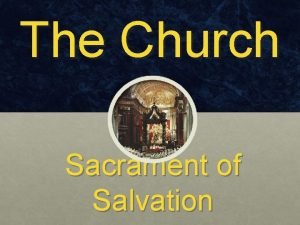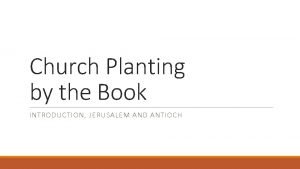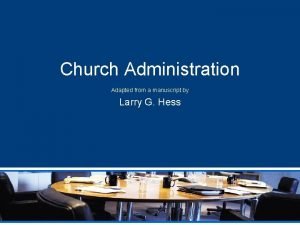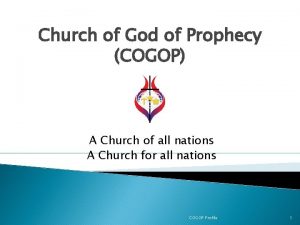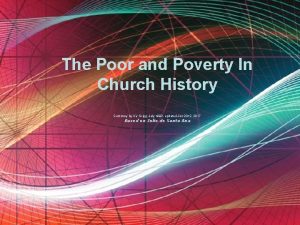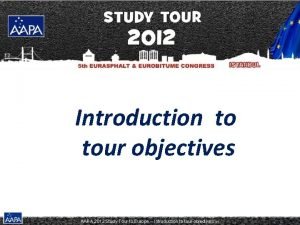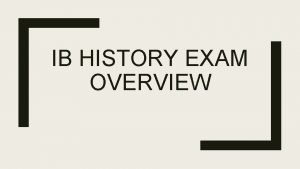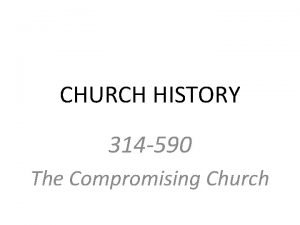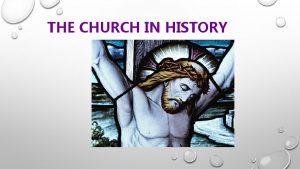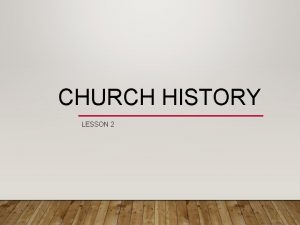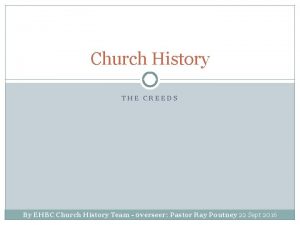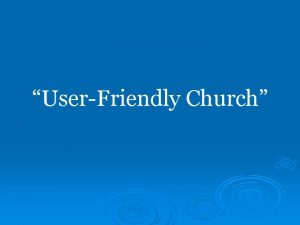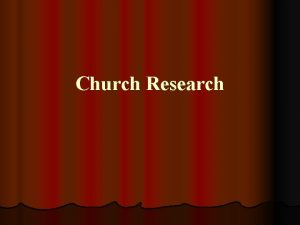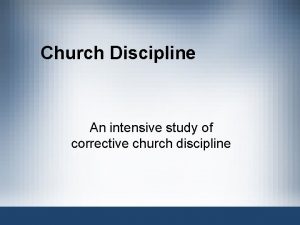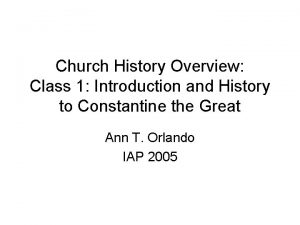Church History Introduction When we study church history




















- Slides: 20


Church History: Introduction • When we study church history we usually follow the divisions – Formation of Roman Catholicism (606 AD) – Roman Cath. & Greek Orthodox division (1054 AD) – Protestant Reformation (1500 -1700 s AD) – Restoration movement (1800 s AD) • It comes out looking something like this. . . (the chart is for example purposes only)


Church History: Introduction • Looking only at the divisions may leave the impression that there were none faithful… • Looking at how Catholicism controlled the Bible (even chaining it to pulpits) may leave the impression that no one else had access… • Churches of Christ are autonomous, no earthly central headquarters or “official” records. • So, were there any faithful churches of Christ during from the early centuries till the 1700’s?

Church History: The Promise • “… upon this rock I will build my church; and the gates of Hades shall not prevail against it. ” (Mt. 16: 18). • “And in the days of those kings shall the God of heaven set up a kingdom which shall never be destroyed, nor shall the sovereignty thereof be left to another people; but it shall break in pieces and consume all these kingdoms, and it shall stand for ever. ” (Dan. 2: 44). • Does that mean we can historically trace it all out? No. Yet the promise stands!

Church History: Seed Principle • We watch the history of the departure – Like watching a train wreck in slow-motion. • The Seed Is The Word (Luke 8: 11). – God’s word is sufficient to produce Christians (2 Tim. 3: 16 -17) & churches. – While we do not have every historical detail (Deut. 29: 29), we do have some available historical evidence…

Church History: Early Evidence • John Cassian (AD 360 – 435) – Rejected original sin and predestination – Taught salvation available to all, free-will, scripture as only authority – Many who agreed hid in southern France for centuries – Shows Catholic influence was not universal…

Church History: Early Evidence • AD 422 – British Isles, a Catholic bishop Germanus, sent there on inspection, wrote that numerous Christians in Britain had rejected Augustine's doctrine of the original sin, practiced the immersion of adults only, did not follow the Roman ritual in their divine service, and did not recognize the hierarchy of Rome, especially the spiritual jurisdiction of the Pope. http: //www. netbiblestudy. net/history/new_page_3. htm

Church History: Early Evidence • “Paulicians” AD 600 - 900 – Name given to denigrate them – Used the NT, esp. Paul’s letters, to show what the church should believe and practice – Called themselves “Christians” – Opposed infant baptism – Required faith and repentance before baptism (by immersion only) – Rejected OT practices – Did not consider Catholics to be Christians – Executed for their beliefs, went underground by AD 900

Church History: Early Evidence • AD 1025 – Roman Catholic Archbishop of Cambrai admits some "repentant heretics" of Lorraine, who avowed to having been taught some years ago by an Italian missionary Gundulf, that the original church of Christ did not believe in purgatory, magic sacramentalism, hereditary sin, children's sprinkling, instrumental music, or the worship of images, saints, and the virgin Mary. – Gundulf told them also that there existed small congregations of "true Christians" in the German Rhineland, in Alsace, and in Switzerland. • AD 999 – 1088, Berengarius – – Opposed infant baptism, Eucharist Taught Scripture to be sole authority Teachings spread throughout Europe Executed in 1088 http: //lavistachurchofchrist. org/LVarticles/Story. Of. The. Churches. Of. Christ. In. Central. Europe. htm

Church History: Early Evidence • AD 1000 – 1200 – Peter of Bruys (Pierre de Bruis) AD 1100 • Opposed infant baptism, mass, holy buildings and altars, prayers for the dead, images, celibacy, transubstantiation • Taught baptism of adult believers for remission of sins • Was burned by a Catholic mob in 1130 – Gregory Grimm tortured to death in 1118 because he had been baptized (immersed) by his grandfather who had been baptized by a traveling merchant

• AD 1118, Gregorius Grimm at Ensisheim, France. – Before tribunal: "If there is here a heretic, not I can be called heretic, for having been buried with Christ in the water of rebirth, I also have had by this baptism remission of my sins. I have been raised by Christ from spiritual death. I received Him and He gave me the power to enter the realm of God to become a happy child of my heavenly Father. “ – Interrogated on his teachers he answered that already his grandfather had been baptized in the little river Fecht by an Italian missionary, and that he supposed that the majority of his fellow believers are inhabitants of Macedonia. – Neither the breaking of his arms and legs by the torture nor the flames of the stake where he was burned alive could make him tell the names of the little group of Alsatian Christians he belonged to. http: //lavistachurchofchrist. org/LVarticles/Story. Of. The. Churches. Of. Christ. In. Central. Europe. htm Church History: Early Evidence

Church History: Early Evidence • AD 1143 – A congregation of over 100 were tortured in lower Rhein because they worshiped autonomously having elders and deacons. • Admitted there were similar congregations everywhere • Authorities could not find the others because of the decentralized nature of the church

Church History: Early Evidence • AD 1146, Henry of Toulouse – Europe and England – Taught a believer’s baptism by immersion – Opposed infant baptism, clergy, feasts, sacraments, penance, etc – Elders of one church offered to publicly debate the issue. They were arrested and burned alive. – AD 1150, Henry caught and executed

Church History: Early Evidence • AD 1449 -1455 – Reginald Pecock, bishop of Chichester, wrote 'Represser of over-much weeting [blaming] of the Clergie'. – The 'Represser' was a refutation of the Lollards, who called themselves Christians, and the church , the church of Christ, who baptized believers by immersion for the remission of sins. – The first major theological work written in English after the Norman Conquest (1066 AD) was to oppose the church of Christ. – Ironically, he was 5 years later killed as a heretic for his use of logic in the repressor… http: //www. traces-of-the-kingdom. org/

Church History: Early Evidence • AD 1529, Simon Fish, preacher at the Bow Lane church of Christ (London) wrote: 'The Summe of the Holye Scripture. ' Printed in Latin and English over several editions. • Title page reads 'The Summe of the Holye Scripture and ordinary of the Christian teaching the true Christian faith by which we be all justified. And of the virtue of baptism after the teaching of the Gospel and of the apostles with an information how all estates should live according the Gospel. ' • Fish's book teaches baptism by immersion for the remission of sins. • For a time Fish was friends with Henry 8 th and his wife, the queen, Anne Boleyn… http: //www. traces-of-the-kingdom. org/

Church History: Early Evidence • AD 1532 – James Bainham preached at the Bow Lane (London) church of Christ, was tortured then burned for preaching the gospel in 1532. – Taught the necessity of repentance & baptism for the remission of sins (by immersion). • AD 1650 s – St. Ives, Cambridgeshire, England – The preacher, Henry Denne, was imprisoned twice for baptising by immersion believers for remission of their sins. Later his son John continued to work with the St. Ives church of Christ and their elders. http: //www. traces-of-the-kingdom. org/

Church History: Early Evidence • AD 1645 and 1525 – Anglican clergyman, Dr Daniel Featly, (a translator of the KJV) wrote of the churches of Christ meeting in London and elsewhere in his work the 'Dippers Dipt', as far back as 1525: – "That baptism ought to be received by none, but such as can give a good account of their faith; and in case any have been baptized in their infancy, that they ought to he re-baptized after they come to years of discretion, before they are to be admitted to the Church of Christ. ” – These churches in the 1600 s were in communication with other churches of Christ in America, before “the restoration movement”! http: //www. traces-of-the-kingdom. org/

Church History: Conclusion • None of the examples show all we would like to know… But they do show: • Catholicism was not universally accepted. • Catholic suppression of the truth failed. • Biblical teachings were taught widely, even before “The Reformation” and before “The Restoration Movement. ” • Through many years people still taught the necessity of baptism & the authority of the Bible. • A complete “succession” is not needed, since the word of God is sufficient (Luke 8: 11 ). • Will you trust Him today (Heb. 11: 32 - 12: 2)?

 The church sacrament of salvation chapter 3 study questions
The church sacrament of salvation chapter 3 study questions Case series
Case series Retrospective cohort study vs prospective cohort study
Retrospective cohort study vs prospective cohort study Method study in management
Method study in management Study less study smart
Study less study smart Phytogeographical zones of india
Phytogeographical zones of india Distinguish between motion study and time study
Distinguish between motion study and time study Differentiate between time study and motion study
Differentiate between time study and motion study Introduction to church planting
Introduction to church planting Introduction to church administration
Introduction to church administration Quiz questions on the history of the church of pentecost
Quiz questions on the history of the church of pentecost Church of god of prophecy history
Church of god of prophecy history History of the church summary
History of the church summary Field study 1 portfolio
Field study 1 portfolio Chapter 1 the study of life
Chapter 1 the study of life Study tour introduction
Study tour introduction World history final exam study guide
World history final exam study guide U.s. history semester 1 final exam
U.s. history semester 1 final exam Ib history of the americas study guide
Ib history of the americas study guide Ap world history jeopardy review game
Ap world history jeopardy review game World history semester 1 final exam study guide answers
World history semester 1 final exam study guide answers
